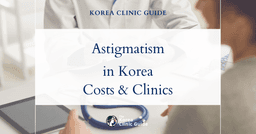Blurred Vision (refractive Error)
Description
Blurred vision, commonly known as "refractive error," is a condition where your eyesight appears hazy or unclear at any distance, often caused by irregularities in the cornea—the clear front surface of your eye. Sometimes described as general vision blur, fuzzy eyesight, or difficulty focusing, this issue can affect daily tasks like reading or driving and is often linked with terms like astigmatism, nearsightedness (myopia), or farsightedness (hyperopia). People experiencing persistent blurriness, wavy vision, or ghost images may be suffering from refractive errors due to corneal problems, such as keratoconus or corneal irregularity. Modern treatments, including advanced laser eye surgery options like LASEK in South Korea, offer effective solutions for those who want clearer vision without relying on glasses or contact lenses. If you notice that your vision remains blurry even with corrective lenses, or if you have been told you are not a candidate for standard LASIK surgery due to thin or irregular corneas, exploring tailored solutions in Korea could help you achieve lasting visual clarity.
Procedures that treat this ailment: LASEK
Search
Categories
Related Posts




Top Blurred Vision (refractive Error) Clinics
Glory Seoul Eye Clinic
Gangnam Station
Free consultation from the clinic
At Glory Seoul Eye Clinic in Gangnam, a wide range of eye care treatments and procedures are offered. Below is an in-depth look into their primary services including LASIK, LASEK, IOL (Intraocular Lenses), presbyopia treatment, and cataract surgery. LASIK (Laser-Assisted In Situ Keratomileusis) Pre-operative Examination: Comprehensive evaluation including corneal thickness, eye pressure, and detailed mapping of the eye’s surface. Procedure: Uses an excimer laser to reshape the cornea for correcting myopia, hyperopia, and astigmatism. Post-operative Care: Includes medication for comfort and healing, along with follow-up examinations to monitor the recovery. LASEK (Laser-Assisted Sub-Epithelial Keratectomy) Pre-operative Examination: Similar in-depth eye examination as LASIK to determine eligibility. Procedure: Involves creating a thin flap in the epithelium, then using a laser to reshape the cornea. Suitable for patients with thin corneas. Recovery: Includes a post-operative kit, bandage contact lens to promote healing, and follow-up checks to ensure proper healing. IOL (Intraocular Lenses) Consultation and Evaluation: Diagnosis of lens-related issues and determination of the appropriate IOL type. Procedure Options: Phakic IOLs: Inserted without removing the natural lens, suitable for patients who are not candidates for corneal refractive surgery. Refractive Lens Exchange (RLE): Replacement of the eye's natural lens with an artificial IOL, often used for presbyopia or high lens prescription. Post-operative Care: Follow-up visits to adjust vision correction if necessary and ensure proper lens adjustment. Presbyopia Treatment Diagnosis and Evaluation: Identifying the degree of presbyopia through comprehensive vision tests. Treatment Options: Monovision LASIK: Correcting one eye for near vision and the other for distant vision. Multifocal IOLs: Replacing the natural lens with a multifocal IOL to improve vision at all distances. Corneal Inlays: Implanting a small device into the cornea to improve focus on near objects. Cataracts Pre-operative Assessment: Detailed eye exam to evaluate the extent of the cataract and eye health. Surgical Procedures: Phacoemulsification: Small incision cataract surgery using ultrasound waves to break up the cloudy lens, followed by IOL implantation. Extracapsular Cataract Extraction (ECCE): Removal of the cloudy lens in one piece, followed by IOL implantation, typically for advanced cataracts. Post-Surgical Care: Monitoring for complications, managing discomfort, and ensuring proper healing after IOL placement. Glory Seoul Eye Clinic in Gangnam focuses on providing a holistic and patient-centered approach to eye care, ensuring that each patient receives the best possible outcome for their specific vision needs.
learn more

